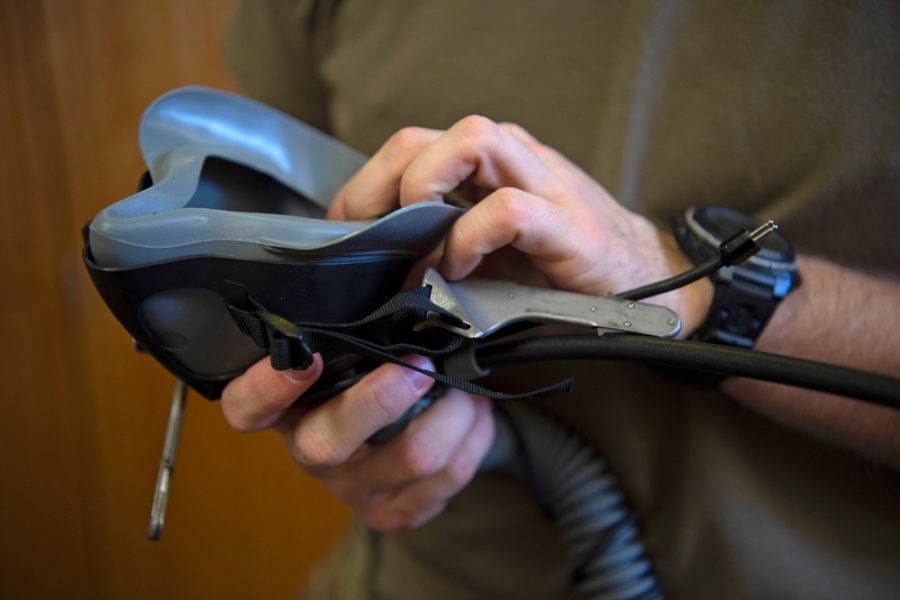The Department of the Air Force’s annual Spark Tank competition takes place March 4, as six teams will take to the stage at the AFA Warfare Symposium in Orlando, Fla. Each team will pitch the most senior leaders in the Air and Space Forces on how their innovations can save money, improve the lives of Airmen or Guardians, and transform the department.
Air Force Magazine is highlighting one team each day from now through March 3. Today, we look at “Custom Facemasks for Fighter Pilots and Beyond,” led by Maj. Ryan Sheridan from the 10th Air Base Wing at the U.S. Air Force Academy.
Hypoxia, or a lack of oxygen to the brain and muscles, is a constant concern for the Air Force—issues with oxygen have caused crashes, grounded fleets, and led to programs studying the problem.
Now, a dentist stationed at the U.S. Air Force Academy believes he has an answer for at least one problem that can lead to hypoxia.
Maj. Ryan Sheridan isn’t a pilot, but he stumbled on a problem one day while deployed and speaking with one of his medical colleagues—the flight surgeon responsible for fighter pilots.
“He was just kind of expressing to me that they were having significant pain, mainly among the bridge of the nose,” Sheridan told Air Force Magazine. Some pilots were even removing their oxygen masks during flight, which can lead to hypoxia.
It’s not the first time that medical professionals have expressed concern about oxygen masks. A 2013 academic study found that half of F-16 pilots surveyed in the Royal Netherlands Air Force had discomfort or pain around the nose as a result of their masks.
Most of the pilots in that study wore MBU-20/P oxygen masks, the same mask that most Air Force pilots use. Studying the issue further, Sheridan was surprised by what he found out about 20/P masks.
“The 20/P oxygen mask has five stock sizes, right? And those five stock sizes are designed to fit … the majority of our pilots,” Sheridan said. “But it’s not designed to fit any one pilot. It’s supposed to fit most pilots.”
Given his professional background, Sheridan was confused.
“For me, making a crown for a patient or making a tooth for a patient, the notion of taking like 10 different stock sizes of crowns and trying to make them fit every single tooth that I have to fix, the notion is just absurd,” he said. “I understand that in the manufacturing world that’s completely different. But for me, you know, my life is made around making customized objects for individuals.”
Sheridan had previously worked on an idea early during the COVID-19 pandemic to build customized N95 masks, taking advantage of the computer-aided design and manufacturing technology already widely used in dentistry, facial scanning technology available on smartphones, and 3-D printers.
After hearing about the pilots’ discomfort, he shifted the idea slightly to creating custom silicone inserts for oxygen masks. Not only will it be better for pilots, the technology needed is widely available and relatively inexpensive, especially compared to other Air Force efforts.
“To me, this just seems like a logical progression of some of the efforts that we’ve done as the United States Air Force to customize what we’re doing for fighter pilots,” Sheridan said. “Like if you look at the F-35, they have a helmet that requires a full head scan, right? That helmet cost $400,000.”
But Sheridan’s idea almost didn’t make it into Spark Tank. After a PCS move in the summer of 2021, the custom facemask idea fell by the wayside, and he wasn’t planning on submitting it.
Then, around August, an email from Chief of Staff Gen. Charles Q. Brown Jr. went out to the force—“basically, it was just a call to action,” Sheridan recalls. It stuck with him.
“I just decided, you know what, what the hell, I’ll throw it in there,” Sheridan said. “That kind of just lit the fire under me, and I started putting stuff together, and then I submitted it and then when I talked to somebody here at USAFA … she started getting really excited about the idea and, so I just kind of kept rolling with it.”
While Sheridan isn’t a pilot himself, he’s talked to plenty of aviators about the idea, and “there’s some excitement about it,” he said. But as of yet, he hasn’t been able to test out the idea on actual fighter pilots. Small group testing is something he hopes to pursue in the near future, but for the time being, he said, he just wants more information.
“I think the biggest thing that you really need to do is just collect the data. … Do we need to make these for every single pilot? I don’t know. I don’t know if that’s the case,” Sheridan said. “But I think that the biggest thing that we can do is just kind of collect data and allow our senior executive officers to … interpret that data and help them figure out where we need to go with the next steps.”
Read about the other Spark Tank finalists:
- Maj. Giselle Rieschick, 99th Medical Support Squadron, Nellis Air Force Base, Nev.: “Blood Delivery by UAV”

